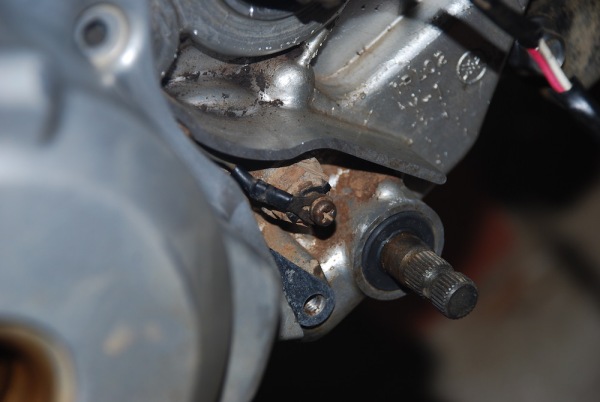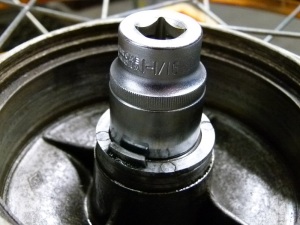If you read my fairly recent post on the AG200 12V accessory outlet, you may recall me mentioning that I would discuss my recommended method of connection to the accessory plug in a separate blog post? Hereth the separate post! So read on folks to discover what I do to connect up the wiring to the AG200’s 12V accessory outlet…
To begin, please respect my right to be a lazy bludger (it might have something to do with it being new years day as I write this!) and quote a section from the previously mentioned post;
“So what’s involved with hooking something up to this thing…what do we need? I figure I need to do a whole separate blog for this procedure because I have seen these plugs bodged up so bad. Most of the time the protective rubber boot is just left off and/or bare wire is looped around the terminal screw of the plug and left at that! Possibly the main problem lies with standard automotive crimp lugs don’t fit under the boot when they are screwed to the terminals. The terminal screw size is M3 (3mm) so a decent terminal that can fit under that boot is not exactly mainstream, especially since the said terminal (a good one!) requires a special tool to crimp it.”
What’s so special about the lugs (henceforth called ring terminals) I’m recommending here? Once again I’m going to let new years day lethargy kick in and (if you’re interested) flick you off to a website that will allow you to go deep into wiring for motorcycles. Check out Cycle Terminal and you can learn all about best practice currently (for the home hack!) in this field. This site will, specifically, tell you all about open barrel crimp connectors. After you get through all this info you may notice a problem; the screws on the AG200 accessory plug are metric M3 items and there are no M3 ring terminals you can buy on this site. Not their fault of course as I must admit I haven’t seen anything as small as M3 used on any bike electricals in my travels. But I have seen them used in general electronics use. In fact M3 stuff is used quite a bit in electronics, especially the electronics I’ve been involved in.
What we need is some non-insulated, open barrel connectors in a M3 ring terminal (crimped). Bit of a mouthful huh? Have a close look at it in the photo here, you will see an innovative design where there are two separate crimp components of the terminal; the section close to the ring that clamps the copper cable that makes the electrical connection, and the second part that clamps the insulation to form a strain relief. Both of these sections fold over their respective cable section and pinch them tight. You won’t find them (these M3 ring terminals) at your local automotive outlet or even the run-of-the-mil electronics stores like Jaycar or Altronics in Australia. You may need a specialist electronics supplier like Mouser or Digikey, and they may have a minimum purchase of 6000 (Mouser) of them! Bit beyond the average AG200 punter eh?
The two crimp sections on these terminals have to pinch over in separate diameters, so you need a specialist crimping tool to do it correctly. And yes, the correct crimping tools can be expensive and I have found (like most things in life) the quality of the connection is proportional to the money you spend on the tool for the job! The crimping tools can range from $30 for a cheap one (most will have to crimp the terminal in two separate actions) which will wreck more terminals than it will terminate, to $300 and up for one that works well.
Of course having said all this, there still will be the age-old debate on whether to crimp or solder and in my early days as a technician I was defiantly in the solder-everything camp. Then I got a job in the two-way radio field where I saw the effects of soldering terminals in harsh environments. The issues I continuously saw (and had to repair) in my day to day work was the failure of soldered connections even when (rarely) they had some some sort of attempt at strain relief. Solder will “wet” up the multi-strand wire and create a shear point. All the movement whether it was thermal or mechanical based would concentrate at the shear point and eventually the copper would fracture. In extreme cases, the cable/connector termination would only last a few days. A cheap and cheerful insulated automotive crimp would crush (no pun intended) the soldered termination for reliability. This is why you will see no soldering in my recommendations unless the cable resistance is critical and the cable is thick so it can be strain relieved effectively, like high current starter motor cables.
At left you can see a crimped set of ring terminals using about 20cm of red and black 18AWG, multi-strand cable. If you look closely at the pic at right with the cables installed on the plug, you will notice I install the ring terminals upside down on the plug terminals, this is to help with the alignment with the holes in the rubber boot when you slide it on. I find it doesnt hurt to bend them towards each other a bit as well which helps it all go together a bit easier. The termination at the end of the pigtails is up to the owner of the AG200 and dependent on the application. The cable I used is rated at 7.5Amps so it is over the rated maximum current of 6Amps and I would highly recommend adding a fuse rated for your device even though the accessory line is fused. If you’re a belt and suspenders type of person then I would also suggest a little squirt of your fav lubricating fluid (WD40, CRC 226) on the terminals before you button them up and maybe a touch of neutral cure silicon on the rubber boot where the cables exit.
And please, please, please, please ***PLEASE*** check the polarity of your plug cables with a multimeter ***BEFORE*** connecting any device to it. Reverse polarity lets smoke out!
And just to finish, I know what you’re thinking – “who cares AGman! I’m never going to go to all this trouble and expense for an old farmerised bike”. Aaaaaand that’s pretty much what I thought you’d think so I have taken all the work and expense out of it and put some pre-made pigtails up on Ebay. Check them out at AG200_central and you may see me add a few similar leads in the future – maybe with a weather-proof fuse holder and a few other options I’ve been thinking about depending on how popular this item is. Have any ideas? Let me know in the comments.
Cheers & Happy New Year!
AGman
P.S. Like my content? Has it helped you out with your AG200? If it has provided value to you and you would like to help me to continue adding content and information, check out my About/Donate page for info on doing just that! Thanks to those that contribute.





 The bearing itself is nothing special. A generic 6005 is the part number and most manufacturers make them. There are a few issues that makes me decide which one to go with though. A lot of guys on the TW and XT forums slap any old bearing in and it seems to work fine for them – that’s great. But I stopped and contemplated the issue for a bit and the following is why I chose the bearing type I did.
The bearing itself is nothing special. A generic 6005 is the part number and most manufacturers make them. There are a few issues that makes me decide which one to go with though. A lot of guys on the TW and XT forums slap any old bearing in and it seems to work fine for them – that’s great. But I stopped and contemplated the issue for a bit and the following is why I chose the bearing type I did.
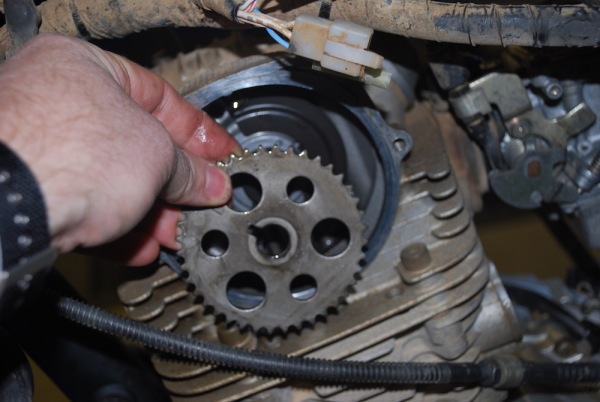


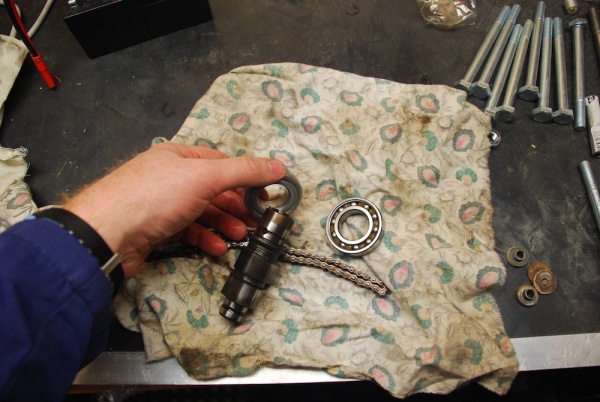


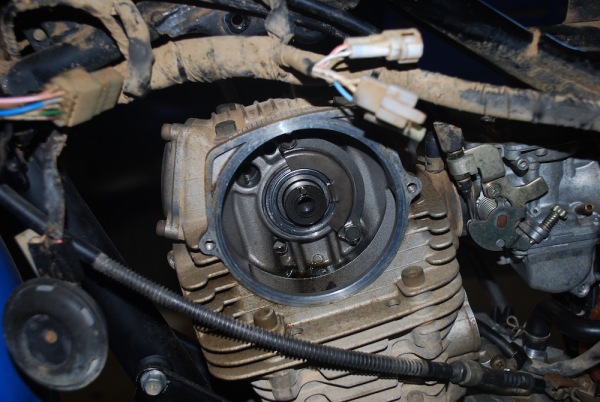






 Remove the spark plug and insert your square drive socket into the flywheel bolt hole and rotate the crank so the timing marks line up. The flywheel mark can be seen at left and you can see the other one in the above photo of the top timing gear. The mark on the gear should line up with the pointer cast into the head right at the top of the gear housing. You don’t have to get too pedantic with it all at this point, the reason I do this first is to get any tension off the valve assembly so when you start undoing bits it wont fly off everywhere because the cam is sitting up on a compressed valve spring.
Remove the spark plug and insert your square drive socket into the flywheel bolt hole and rotate the crank so the timing marks line up. The flywheel mark can be seen at left and you can see the other one in the above photo of the top timing gear. The mark on the gear should line up with the pointer cast into the head right at the top of the gear housing. You don’t have to get too pedantic with it all at this point, the reason I do this first is to get any tension off the valve assembly so when you start undoing bits it wont fly off everywhere because the cam is sitting up on a compressed valve spring.
